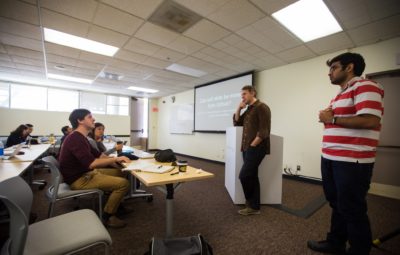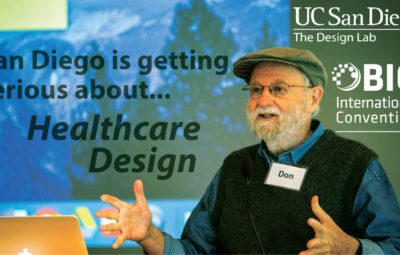#WeAreNotWaiting is the social media movement of folks in the diabetes community who have come together to hack their own health; they’re developing platforms and apps and cloud-based solutions, and reverse-engineering existing, commercial products to help people with diabetes better utilize technology and health data for improved outcomes. And they are organized; in the form of groups such as Nightscout and OpenAPS, these people have emerged as design leaders in the global DIY diabetes community.
I hosted a panel discussion at Design Forward in October to learn more about the #WeAreNotWaiting movement – how real people are really being impacted – and how commercial companies are responding. Panelists included OpenAPS founder Dana Lewis; DIY family patient member Clayton McCook; and Tandem Diabetes Chief Commercial Officer Brian Hansen.

Image: L to R: Steph Habif, Dana Lewis, Clayton McCook, Brian Hansen.
How does someone begin hacking their health?
Dana, who lives with Type 1 diabetes, began by talking with the technology manufacturers a few years ago. She had a very real problem: the alarms on her insulin pump were not loud enough to wake her during night time sleep. Meaning, if her blood sugar dipped to lethal levels while she was sleeping, she would not hear the alert. And there was no way to increase that noise on her pump at that time. Dana went to the commercial companies, “What can you do, can you make it better?” She said the responses she received included, “It works for most people” and “we are working on the next version which should be available in a few years.”
Afraid she might die while she was waiting, Dana looked to social media. Turns out she wasn’t the only one who needed better personalization from her technology. She discovered a few other people living with diabetes had solved this problem by hacking into commercially available systems. Dana reached out and they shared and continued to refine code so that they could write their own scripts for how their systems work. Separate from commercially available systems. Separate from the FDA.
What she experienced was significant improvements and stability in her blood sugars.
BEFORE:

Image: Dana’s blood glucose readings using a commercial system
AFTER:

Image: Dana’s blood glucose readings using a DIY system

Image: Dana’s OpenAPS “rig”
Why are families choosing to use non-FDA approved devices?
When your child is diagnosed with Type 1 diabetes, you “spend the first few years in a fog, trying to learn everything and all the math required to keep your kid alive,” said Clayton. His daughter Lily was diagnosed at age three and is now nine years old. “We started off with one commercial product that worked fairly well, but when Lily wasn’t near us – at school or at the park – we didn’t know what was happening. Nightscout developed a system that enables parents or any caregiver to monitor a loved one with diabetes from afar. When I learned that, I knew I had to have it.”
“There is a lot of encouragement in the #WeAreNotWaiting community. At the core is altruism.”
Clayton further explained, “I was really scared. I’m not an engineer, I’ve never written a line of code, I still find my mind boggled with all of the amazing work happening. Dana and the rest of the community was so supportive; and now my daughter finds herself in range 90% of the time. She’s happy, she’s healthy, and when she goes to school I don’t worry about her.”

Image: Lily, Clayton, Olivia, and Cindy McCook. The McCooks are active members of the #WeAreNotWaiting movement.
How are commercial diabetes companies responding to the DIY community?
“As the commercial guy,” said Brian, “I like what Dana and the community are doing because it puts pressure on us, it puts pressure on the FDA to get there faster. This is raising the bar for what we have to design and bring to market as fast as possible. There is no space in healthcare more passionate than the diabetes space.”
One differentiator between the DIY community and commercial companies is on-demand customer support. “We have a 24/7 support system available to the patients who use our devices” confirmed Brian.
“I know that the community wants us to open our systems; the newest commercially available systems cannot be customized by DIY users. As an FDA approved device, we can’t do that.”

Image: Tandem Diabetes X2 insulin pump
What about the FDA?
OpenAPS and Nightscout regularly communicate with the FDA. Dana explained, “We have talked with them and they understand why we are doing what we are doing.”
The #WeAreNotWaiting community is not doing anything commercial. No money is changing hands. And the FDA serves to regulate commercial activity. Related to this movement, the FDA has decided to exercise something called “enforcement discretion.” So when people hack their own health technology to change the system, they remove themselves from the protection of the FDA.
One thing is certain: the next few years will reveal which commercial companies can catch up to the customization experience a DIY system provides. Those companies will win.
By, Steph Habif
*The author does formal work with UCSD Design Lab, and Tandem Diabetes.



